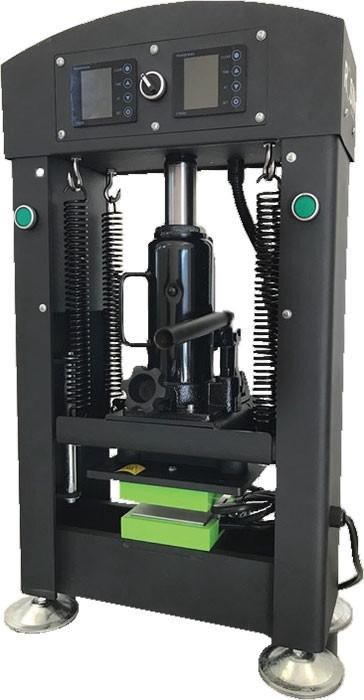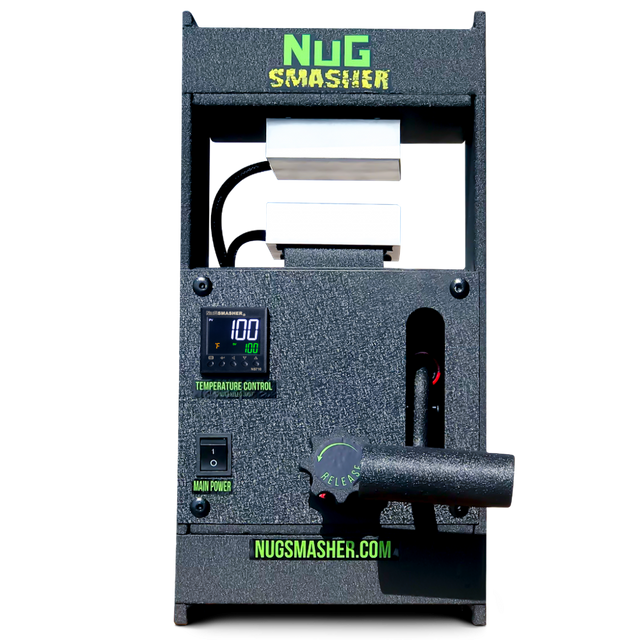With Rosin being the way to go for many cannabis consumers, being the safest way to extract it, perhaps the next best thing to do now is find a way to have a constant supply of it. And if you prefer rosin as your medium for consumption, you’d want to have a good supply, especially if you prefer a particular strain. That’s why many turn to a rosin press and consider it a good investment.
With the advent of rosin, more companies are offering affordable solutions. Add to that the relaxed regulations in growing cannabis at home. So if you’re a home grower, and want rosin whenever you want it, it makes sense to get your own rosin press.
And the good thing about rosin presses? There are many to choose from. This brings us to which rosin press to choose, especially if you’re just starting out. There are a few things to consider when choosing a rosin press.
Do you have a lot of space to spare, or do you need something compact?
Do you need something more discreet, or is noise okay in your household?
How much material are you looking to extract each time?
Given these considerations, here are some recommendations to check out.
How Much Flower Do I Have?
Knowing how much flower you plan to press will help you determine what type of press and what size of rosin plates you need to work with. If you’re only pressing a few grams of flower here and there, a hair straightener will be enough to get you started and familiar with the process.
If you’re growing your own cannabis and have access to several ounces of flower at a time, building your own rosin press and purchasing quality rosin plates will probably be the most effective approach.
Do you need to grow your own cannabis to press rosin? Absolutely not! But it can be beneficial. Learn more here.
One of the first things to decide is which type of press you’ll use for rosin extraction. How much source material you plan to process will dictate what type of press you should use.
It’s not feasible to press pounds of flower with a hair straightener (but it has definitely been done!) and likewise you don’t need a 20-ton press if you’re just squishing a few grams here and there for personal use.
After you determine how much source material you’ll have and the amount of flowers you’ll be pressing on a regular basis, it’s time to come up with your rosin press set up.
Rosin Tech H-Frame 12 Ton Hydraulic Rosin Press
Features:
The Rosin Tech Rosin Press is built for our commercial producers. Operate the hydraulic force manually or connect to an air compressor to speed up and improve your control over each press. This is a Hydraulic Rosin Press that can be used manually or there is an option to connect an air pressure source which will speed up the process and let the user have more control of the pressing process. This particular Rosin Press is built for heavy duty pressing and can achieve top quality yield using a hydraulic press. When looking to buy a Rosin Press, one of the first things people look to see is the pressing mechanism, which is usually a choice between either a hydraulic or pneumatic pressing. Both of these types of presses achieve similar results and are highly efficient and get the job done without too much strain or effort.
NugSmasher OG Original 12 Ton Rosin Press
Features:
The NugSmasher rosin press is the brand’s first plug ‘n play rosin press and certified bestseller. This manually-controlled rosin extraction machine features 12 tons of pressure and two 4X4 inches heated plates, capable of pressing up to 14 grams of cannabis materials. Also featuring Dual Heating Elements and an Accurate Temperature Control, the NugSmasher Original is one compact machine manufactured from solid structural steel. Made out of a solid steel body, the original NugSmasher has been proven to be strong, durable, and capable of outlasting even the busiest production days of businesses everywhere. This rosin press has large 4”x4” smash plates that allow you to produce rosin extracts in bigger amount so you can maximize productivity and increase the profit of your business.
Important Rosin Press Qualities
The most important qualities in a rosin press are:
Pressure capacity
Pressure delivery
Temperature
Plate shape, size & material
Processing capabilities
The purpose of these machines is to extract the purest cannabinoids, terpenes, and flavonoids from whole-plant cannabis and hashish. But some devices do the job better than others, and when you understand how the heat, pressure, and construction influence the product quality, it’s much easier to discern between good and bad rosin presses.
Pressure Capacity
Some rosin press machines produce as little as half a ton of pressure; others are capable of a staggering 200 tons of pressure (400,000 pounds of pressure). The pressure capacity is commonly broken down in terms of pounds per square inch (PSI).
The important thing to remember is that more isn’t necessarily better. While higher pressures do result in larger yields (more force equals more sap squeezed from the plant material), you may actually be sacrificing quality when you opt for the maximum PSI. Too much pressure can result in excess fats, lipids, and chlorophyll seeping into the rosin.
Pressure Delivery
It’s not enough to consider the amount of pressure; you also have to consider how that pressure is delivered. In other words, is it manually driven? Is it driven by a pneumatic cylinder? Hydraulic pressure? Electric? The pressure delivery will have a major impact on the speed of your output and the amount of labor required to do the job.
The following are the most common types of rosin presses:
Pneumatic rosin presses (or air press machines) use pressurized air to deliver the necessary force. You’ll need an air compressor (often sold separately) to push air into the machine, creating pressure that moves the cylinder. The cylinder returns to its normal position as the air is released through the valves.
Hydraulic rosin presses rely on the same kind of physics to move the cylinder, but they use compressed fluids instead of air. But whereas pneumatic presses can be activated at the touch of a button, hydraulic presses require a hand pump, foot pump, or other manual-pumping mechanism to achieve the necessary force.
Manual rosin presses are entirely user-driven. There are no compressors to assist with the force delivery; the process is entirely manual, usually guided by a hand crank or similar mechanism.
Electric rosin presses are among the newer entries to hit the market. As the name suggests, they’re powered by electricity; just press a button and let the machine go to work. Unfortunately, there are few noteworthy presses of this variety, and most aren’t very powerful when compared to the alternatives.
Which leads us to our next point…
Temperature Range
There are two generally accepted temperature ranges for pressing rosin.
Cold pressing typically occurs between 130°F and 170°F for about 1 to 5 minutes or longer. This will give you a budder- or batter-like consistency. Cold pressing is great for maximum terpene preservation, but you can expect lower yields.
Hot pressing typically occurs between 170°F and 220°F for about 45 seconds to 3 minutes. This can give you an oily or shatter-like consistency. The terpene preservation is still high if you keep it below 220°F, and the yields are higher than with cold pressing.
For the best balance of quality and yield, we have found the 210°F — 220°F range to be especially effective for flower rosin. But it will also depend on the type of consistency you’re trying to achieve as well as the type of starting material you’re working with. For instance, if you’re making bubble hash rosin or dry sift rosin, you might want to start on the lower end of the temperature scale, around 140°F to 200°F.
Note that you’ll start to lose terpenes above 220°F. By the time you hit 235°F, the loss in flavor in terpenes becomes especially noticeable. However, that’s not to say that higher temperatures don’t have their uses. For example, if you’re working on late-stage THCA separations, you might go as high as 300°F.
Plate Size & Shape
The heated plates are what separate the rosin from the plant, and their size and shape is extremely important. Some cheap rosin presses use square plates, and this can greatly inhibit the quality of your end product. If the extraction has to travel too far to escape between the plates, you can burn valuable terpenes and end up with inconsistent quality.
The secret is to find rosin press plates that maximize the perimeter-to-area ratio. In other words, you want a larger escape route (perimeter) per square inch of surface area. Every drop of rosin is forced to travel roughly the same distance, thereby ensuring a more equitable heat distribution for your entire extraction with no terpene degradation.
Even Heat Distribution
Even heat distribution is essential for achieving a smooth, consistent texture. Unfortunately, a lot of cheap rosin presses have terrible heat distribution. There are a couple of reasons for this.
First, cheap presses are often made with stainless-steel plates, which distribute heat poorly. In the rosin press market, aluminum heat plates are the gold standard for maintaining uniform heat distribution. That’s because solid aluminum plates have much better thermal conductivity. Thermal conductivity represents the rate at which heat passes through the material, or more simply, the ability of a material to conduct heat. Most grades of stainless steel only offer 6% to 18% of the thermal conductivity of aluminum, and that’s why stainless steel is a poor solution for rosin pressing.
Second, a lot of cheap rosin presses are just poorly designed. Even if they’re made with aluminum plates, they may contain cheap or poorly spaced heating elements. This too will result in uneven heat distribution and an inferior extraction process.
Processing Capabilities
Maximum processing capacity might not be an essential factor for hobbyists and smaller operations, but it’s absolutely critical for commercial users. You want to ensure that your device is capable of producing enough rosin to meet your aggressive daily volume demands and maximize your ROI. Not only that, but the machine should have enough automated functionality to get the job done without the need for multiple operators.
To estimate how much rosin you can produce per pound of weed, consider the following approximations:
Shake: 8% — 15%
Flower: 10% — 25%
Dry Sift: 30% — 60%+
Bubble Hash: 30% — 90%
So if you’re working with an ounce of dry flower, you might expect between 3 and 7 grams of rosin as your output. If you’re working with an ounce of extremely pure bubble hash, you might get as much as 25 grams of material.
Note that your yields will vary based on factors like the moisture content and cannabis strain (some are more resinous than others), so you’ll need to be mindful of your starting material as well.
Conclusion
Getting started with rosin extracts won’t really cost that much, given the different price points for each rosin press. And given the benefits from using rosin, it gets more encouraging to start extracting at home.
It’s because of the demand that technology was able to catch up to offer home solutions for rosin extraction. With that said, you should be able to make an informed decision when choosing a rosin press.

